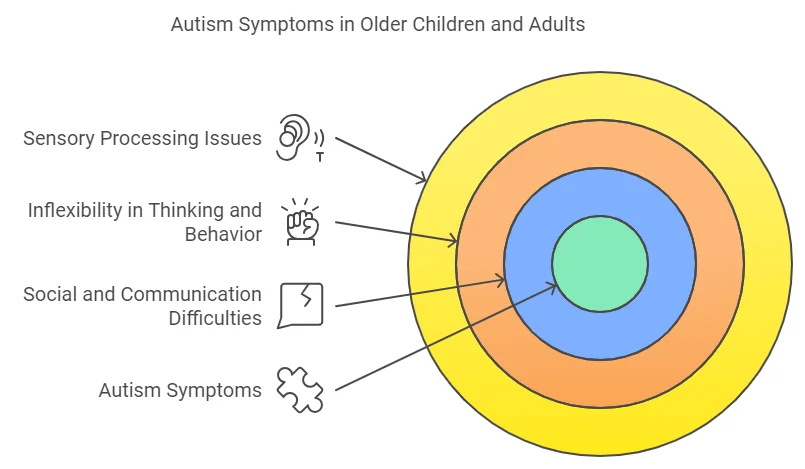Subtle Red Flags That May Indicate Autism in Young Children
The early years of a child’s life are the most exciting period for parents while witnessing several developmental milestones. Every smile, every babble, and every gesture is just like small miracles unfolding. It’s also very important to realize that your child’s development might not exactly follow this timeline and that early intervention is key to dealing with developmental differences. In this article, we outline some of the more subtle red flags that might help you identify the presence of autism in your young child. Understanding these indicators will help you seek timely advice from a healthcare professional and ensure the best possible support for your child.
Remember, having a few of these signs does not mean a child has autism. It only indicates that a further assessment might be useful. If you’re concerned, see your doctor or an allied health professional for further assessment.
1. Limited Eye Contact
Eye contact is one of the fundamental tools of human communication. Very young children usually use gaze to attract the attention of adults, to indicate feelings and to communicate socially. If you find that your child doesn’t consistently make eye contact for example, they might look at a toy but not look back at you to share their excitement — that may be a little red flag of autism.
For instance, if you’re rolling a ball back and forth with your 12-month-old, their typical response would be to look at the ball, make a sound, then turn to you with the look of “Why did you stop?” But a child who doesn’t have this connection via eye gaze may stay looking solely at the ball without returning gaze back to you. That absence may be an early marker that needs to be watched carefully.
2. Not Using Gestures Consistently
Gestures are one of the big ways children communicate before they learn to talk. By around 12 months, most babies will use a range of gestures to let you know what they want. They might reach their arms up to be picked up, point to things they want, or clap to show delight. They might wave hello and goodbye, or shake their head for “yes” or “no”.
Children on the spectrum can be inconsistent with these types of gestures. Instead of pointing to a bottle then turning to make sure you’re following his cue, the child would take your hand and put it on the bottle but not look up. That’s a form of communicating but the point and look in your eyes kind of connection gets lost in that. If your child rarely uses gestures like waving or pointing, it could be worth keeping an eye on.
3. Not Responding to or Copying Gestures
Another warning sign: If your child doesn’t respond to your gestures or doesn’t mimic them. Babies are fantastic imitators—they tend to mimic everything you do, and they want to reenact the world around them. For example, when you clap your hands or wave, your baby usually attempts to imitate those actions. Or, if you have an unfinished thought and you gesture, and say, “Look at the dog!” they’ll usually track your point and attempt to see what you’re showing them.
Kids who do not respond to these cues or do not mimic your gestures might be showing a sign of autism. If, for example, you wave goodbye and your toddler just looks away without trying to mimic you it is something to watch more closely.
4. Rarely Sharing Enjoyment or Interest
Typically developing children are naturally inclined to share their world with the people in their environment. They love pointing out things of interest, then turning back to check that you’re looking, too. If they have a favorite toy, they’ll bring it over and make sure you see it. This is how they include you in their joy.
A child on the autism spectrum may not be able to do this. They might be content playing alone without any desire to share that pleasure with others. They might bring a toy to you and drop it in your lap without ever looking at your face to see your reaction. This lack of shared experience is another red flag to be aware of.

5. Repetitive Actions or Movements
Autistic individuals may also have repetitive actions or body movements. In play, for example, a child on the autism spectrum might become obsessed with a particular aspect of a toy, like spinning the wheels of a car instead of pretending to drive it. They may enjoy watching a ceiling fan spin around or turn a light on and off countless times.
When it comes to the body, children with autism may be seen doing stimming such as hand flapping, toe walking and finger waving. Such actions become a subtle yet telling indicator of autism when they become the primary way a child plays or moves.
To gain deeper insight into autism and the challenges of raising autistic children, explore this heartfelt journey shared by a mother of two on her path to understanding autism here.
6. Not Responding Consistently to Their Name
By about 12 months, children usually respond to their name when called. If you call your toddler’s name three or four times and they don’t turn around, even when you are close by, that might be a red flag. It is important to remember, however, that this behavior in and of itself could also be related to problems with hearing so that would need to be ruled out by a professional.
When your child doesn’t respond to his name, this doesn’t necessarily mean he is being stubborn or deliberately ignoring you; he may not even acknowledge his name has been called. If you repeatedly see this happening, it is worth mentioning to a doctor.
7. Limited Babbling and Early Vocalizations
Babbling is a very important phase in the development of speech, and at 12 months, most children start to babble conversationally. In other words, if one speaks to them, they turn around and say something with sounds, as if they were trying to answer. Such echoing babbling is an early form of communication and social engagement.
If your child isn’t babbling, or the baby’s vocalizations don’t appear to be directed towards you or others, these could be early signs of autism. Typically developing toddlers will change the pitch and tone of their babble as if they are having a real conversation-“ba-ba-ba” might become something that sounds more like a sentence. If this isn’t happening, it’s worth observing a little more.
8. Repetitive Body Movements as a Form of Play
Some kids enjoy spinning around in circles, flapping their hands, or doing the same action repeatedly. These repetitive movements aren’t always a cause for concern, but they might raise a red flag if these activities are the primary way your child plays or expresses excitement. For instance, toe-walking all the time, not just some of the time, could be a warning sign. Other examples of repetitive movements include shaking their head side to side or constantly flicking their fingers.
These are behaviors that, if continued over weeks or months and apparently on the increase, one should seek advice from a healthcare provider.
Conclusion: Recognizing Early Signs and Taking Action
Early detection of autism may greatly impact a child’s development and their interaction with the environment. Though most of them are quite subtle, they give vital insights, allowing parents to decide appropriately when to seek further assessment in their children. If your child is showing one or more of these behaviors, it’s important to know that staying calm is in order, and seeking further help from professionals is better done than not.
Early intervention can dramatically improve the prospects of children with autism, allowing them to communicate better, interact with others, and do well in general. Remember, every child is unique, and developmental timelines can be quite different. Trust your instincts as a parent, and don’t hesitate to seek help if something doesn’t feel right.
Want more insights into your child’s development or have concerns about their behavior? Check out our in-depth developmental milestone checklist here to understand what to expect and when to seek help.

